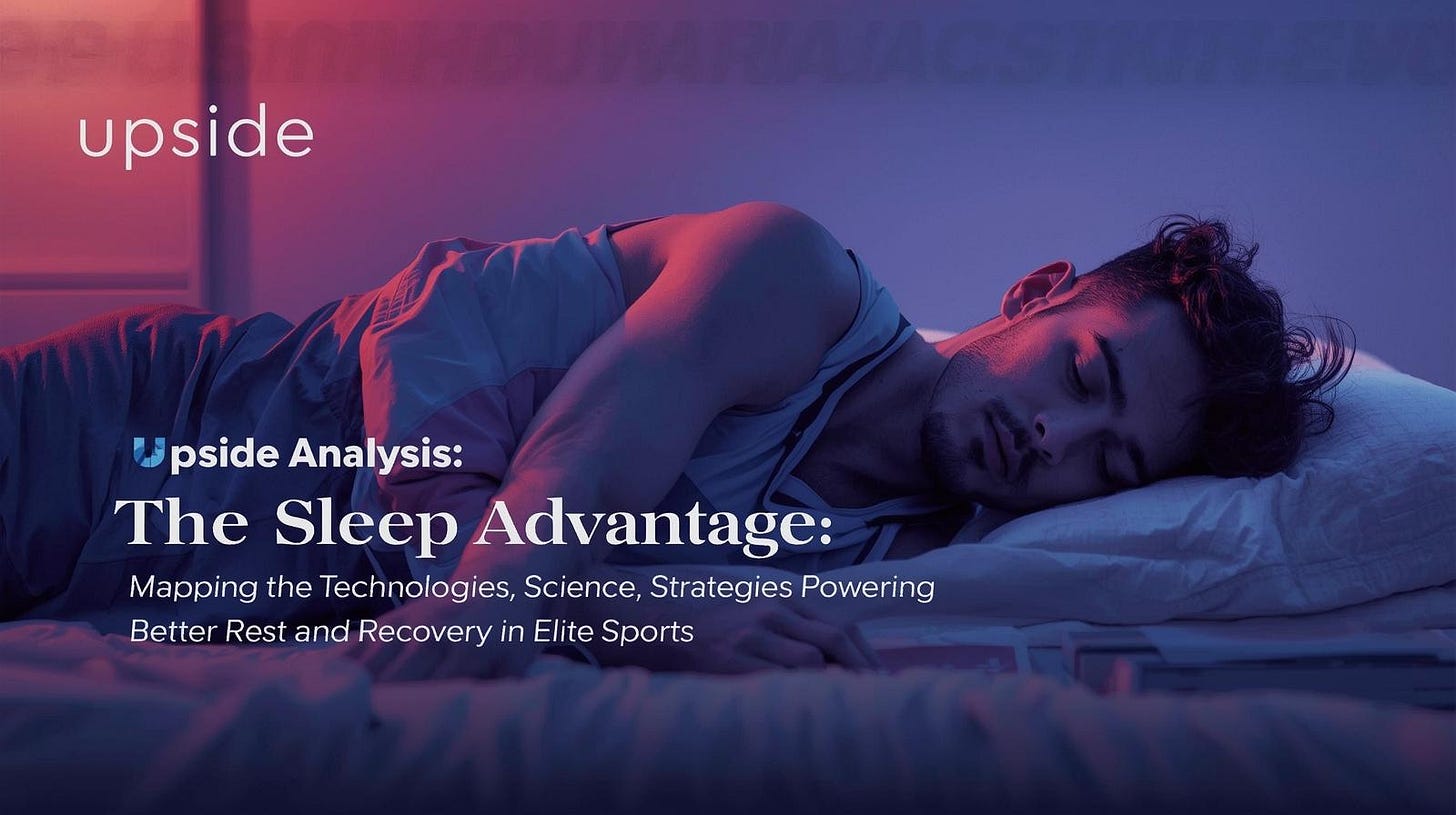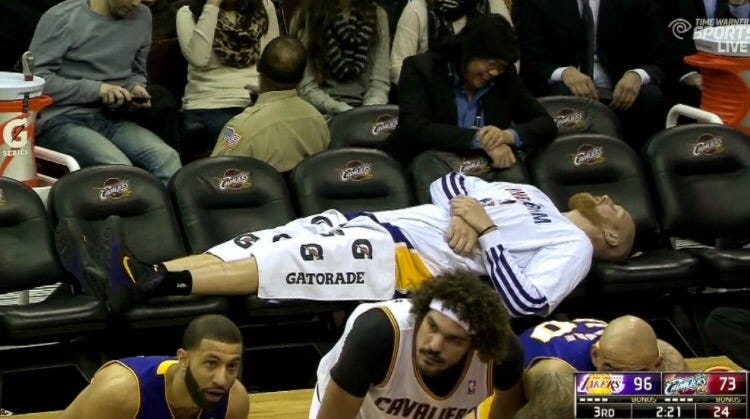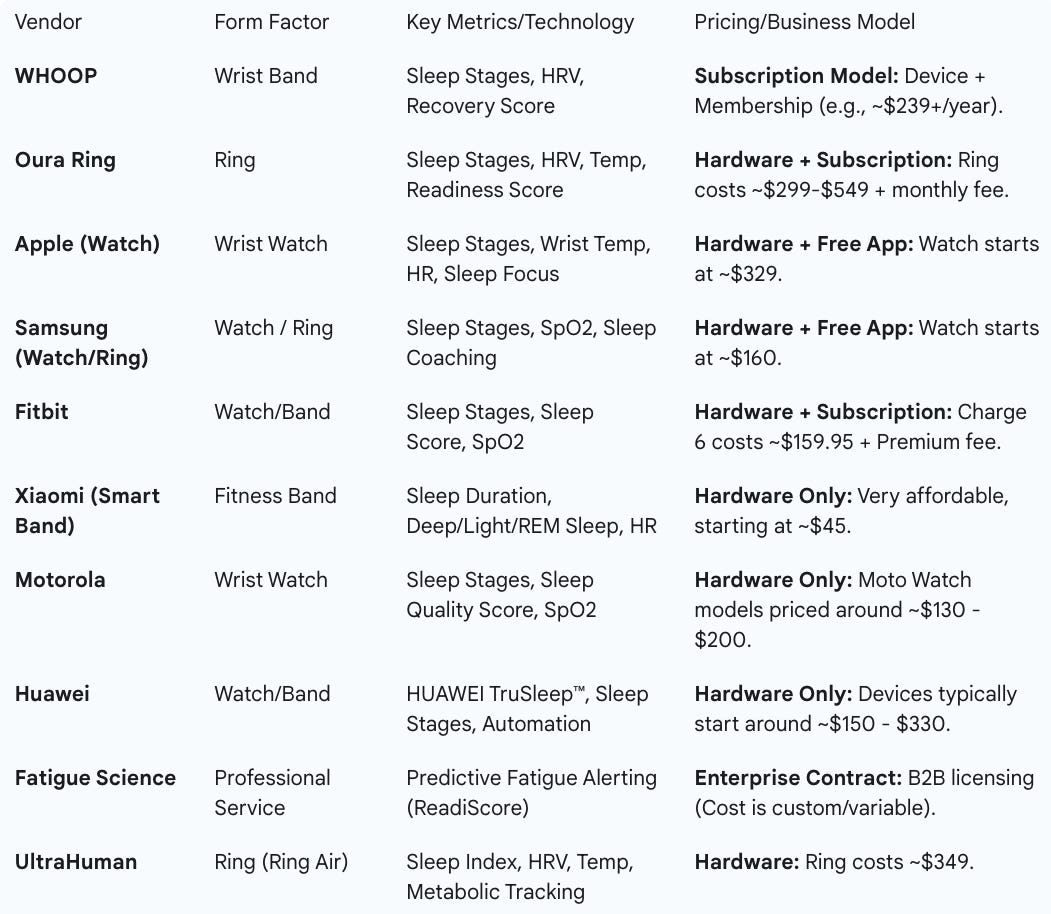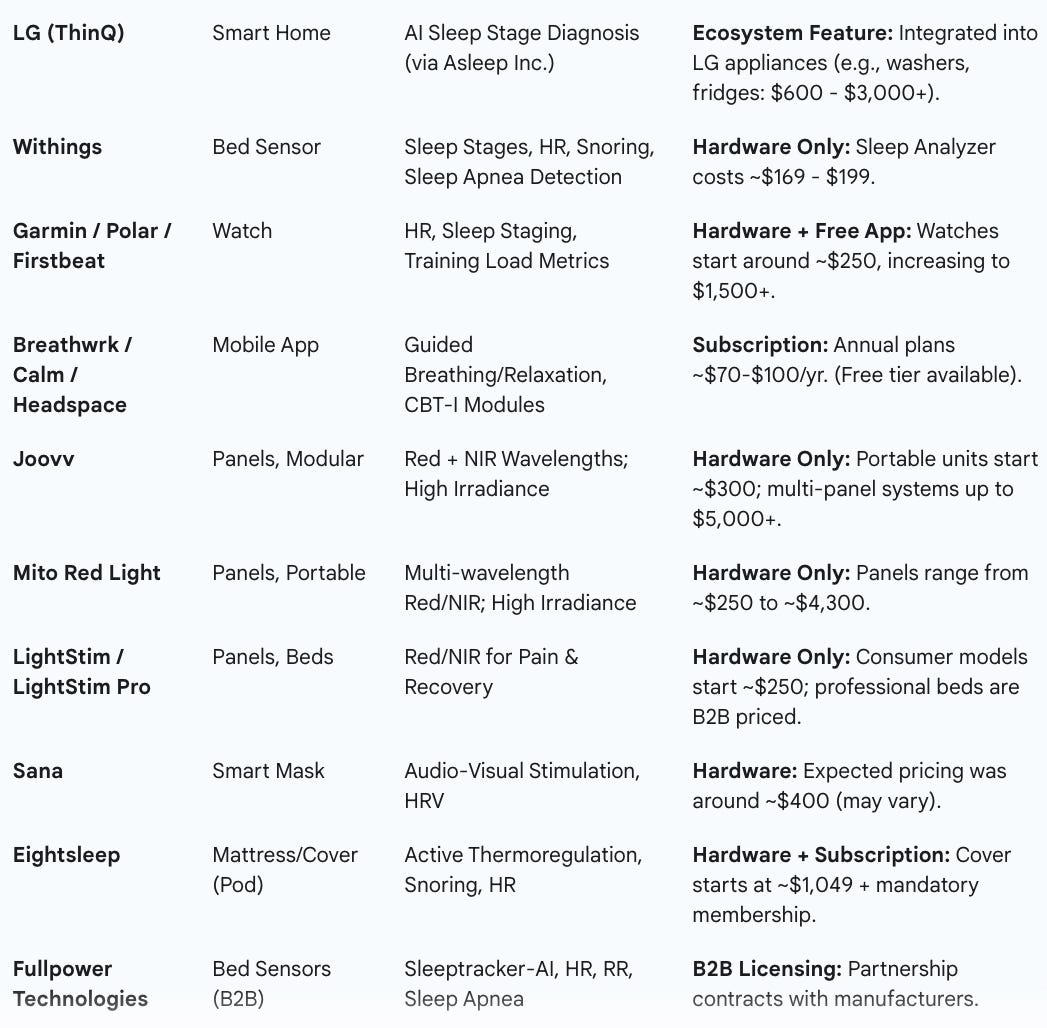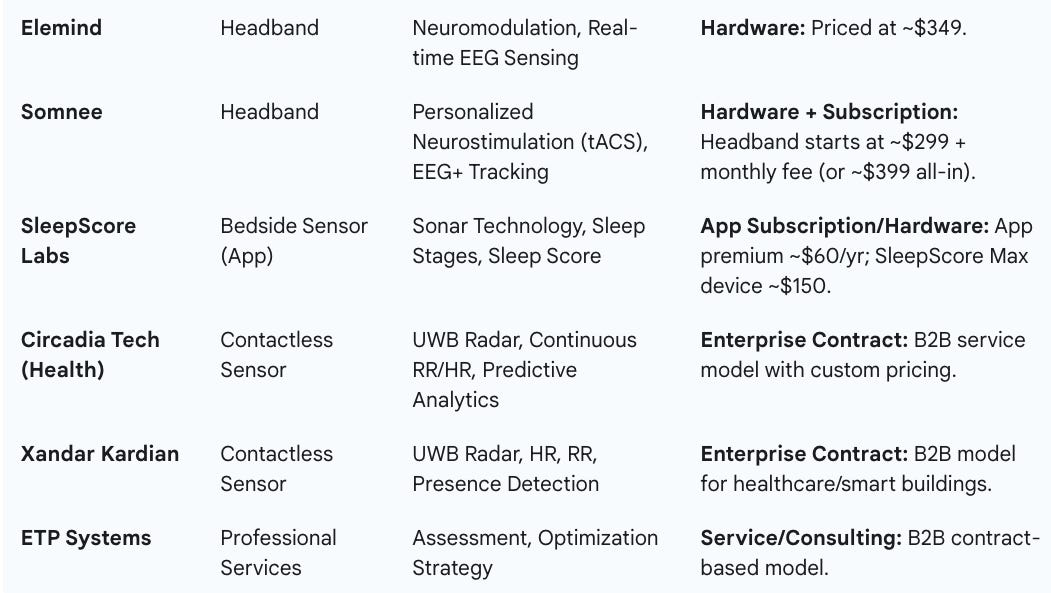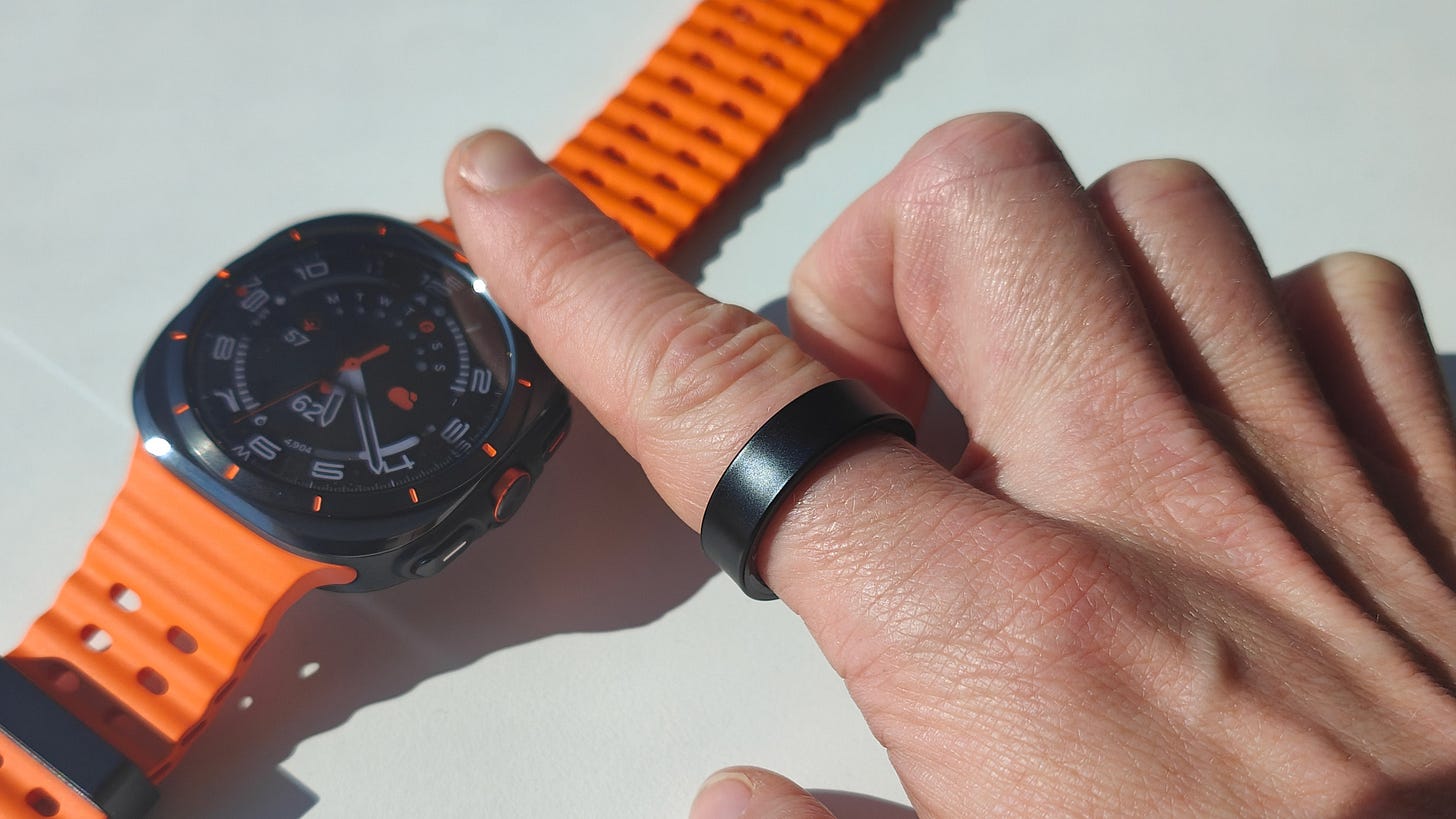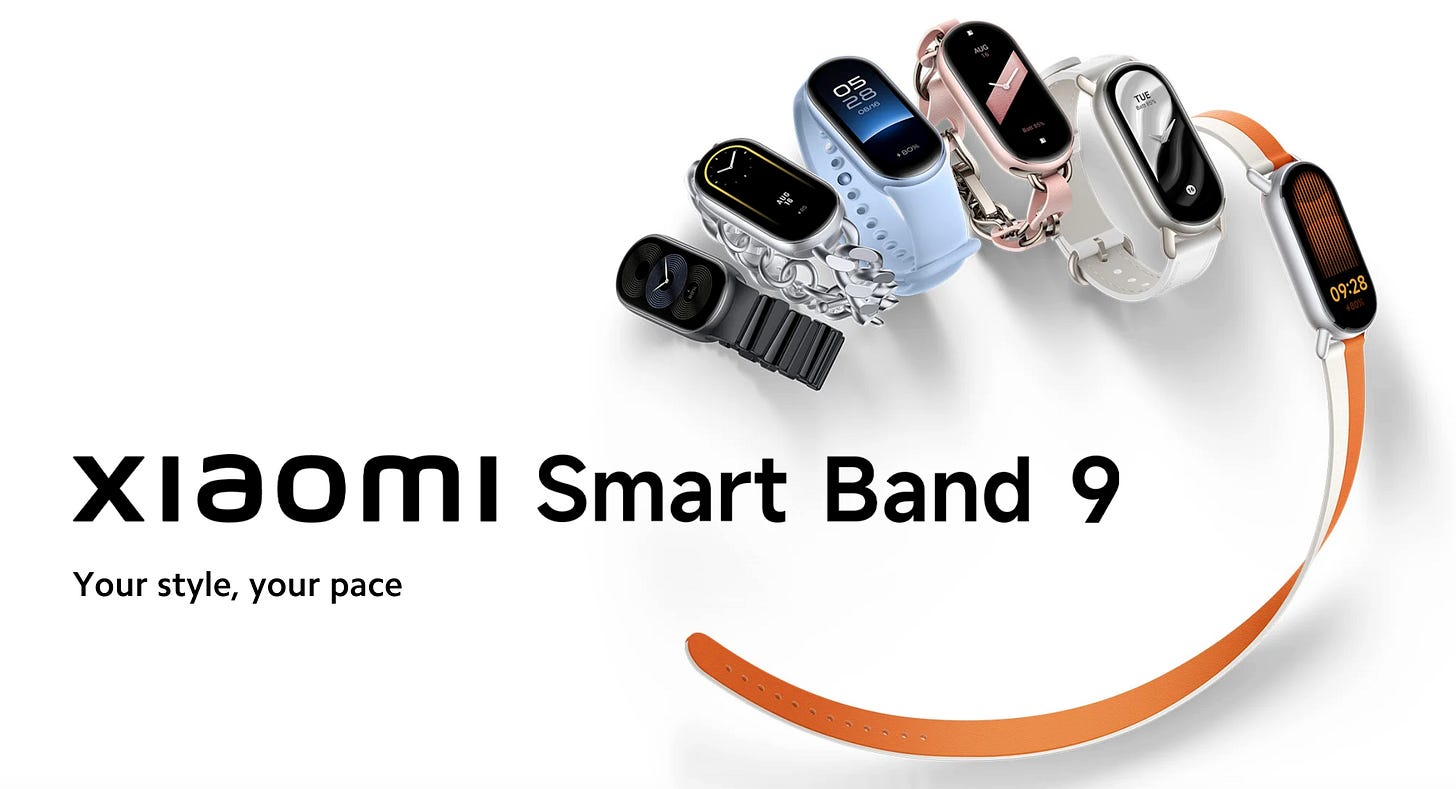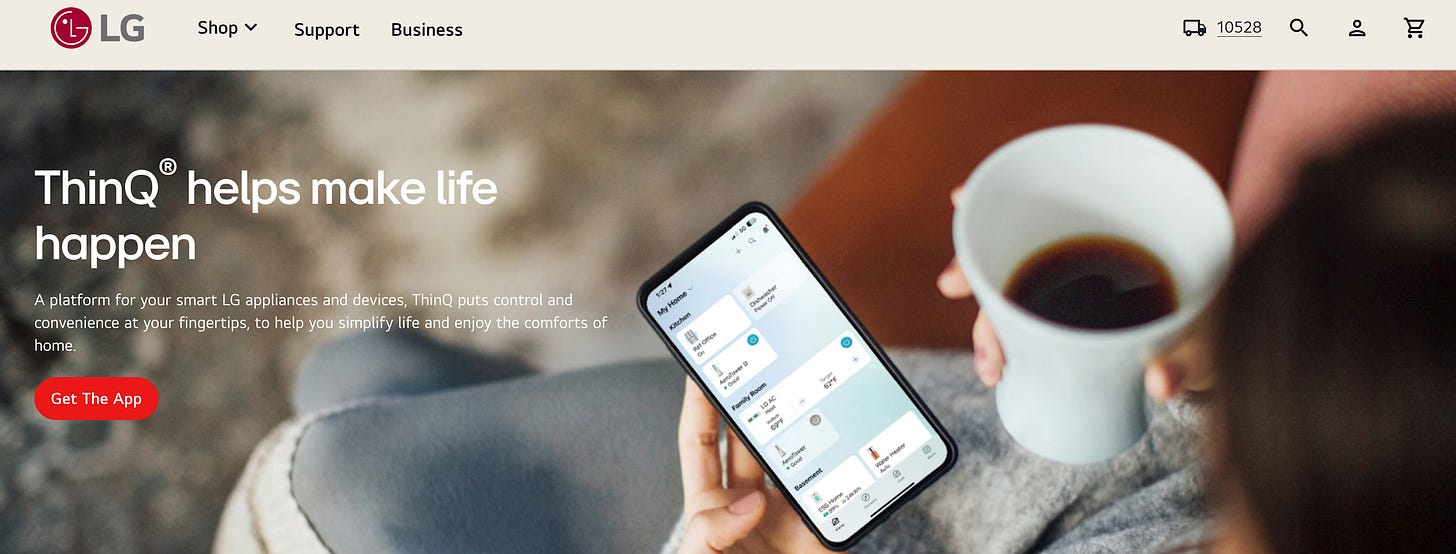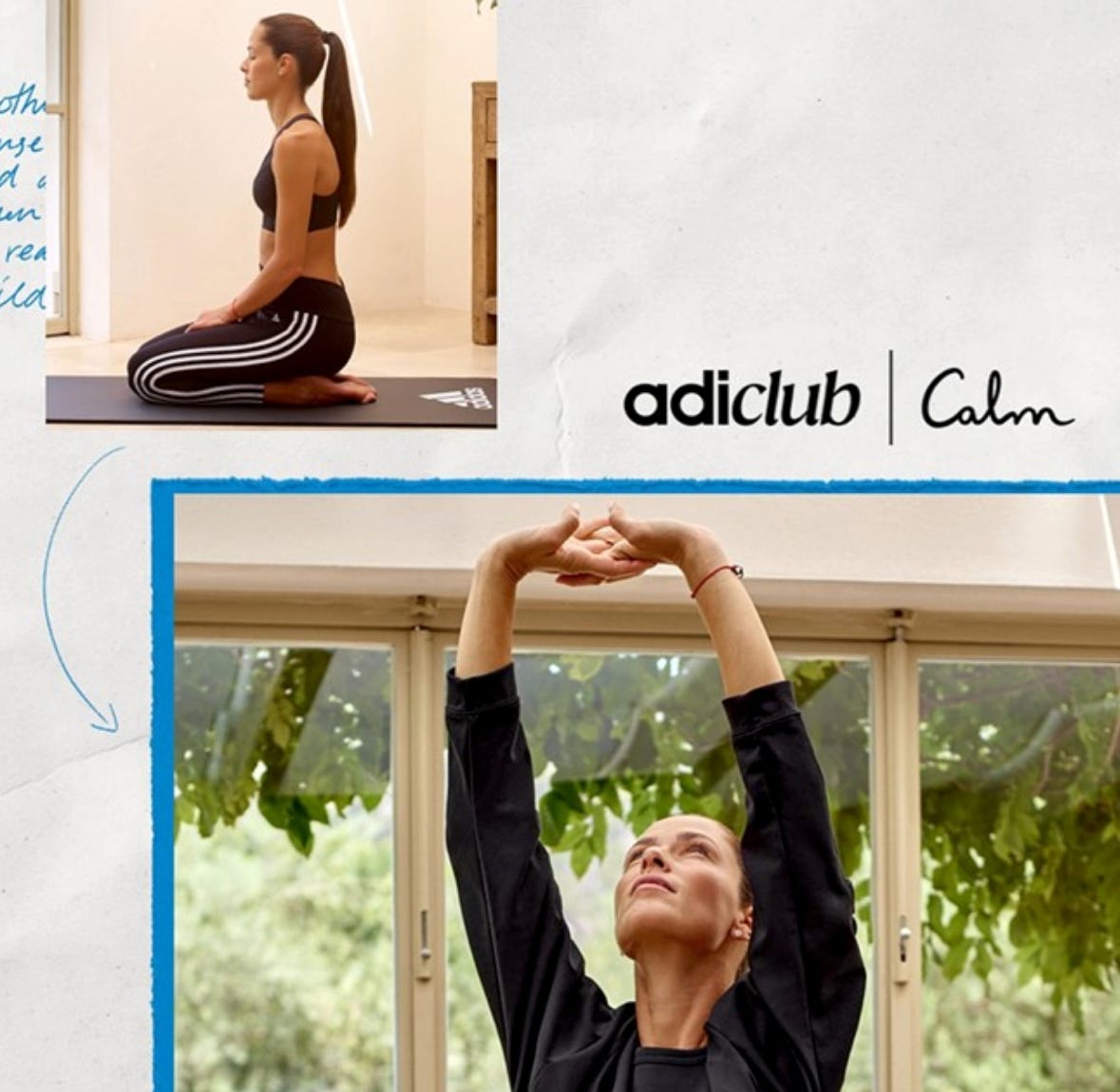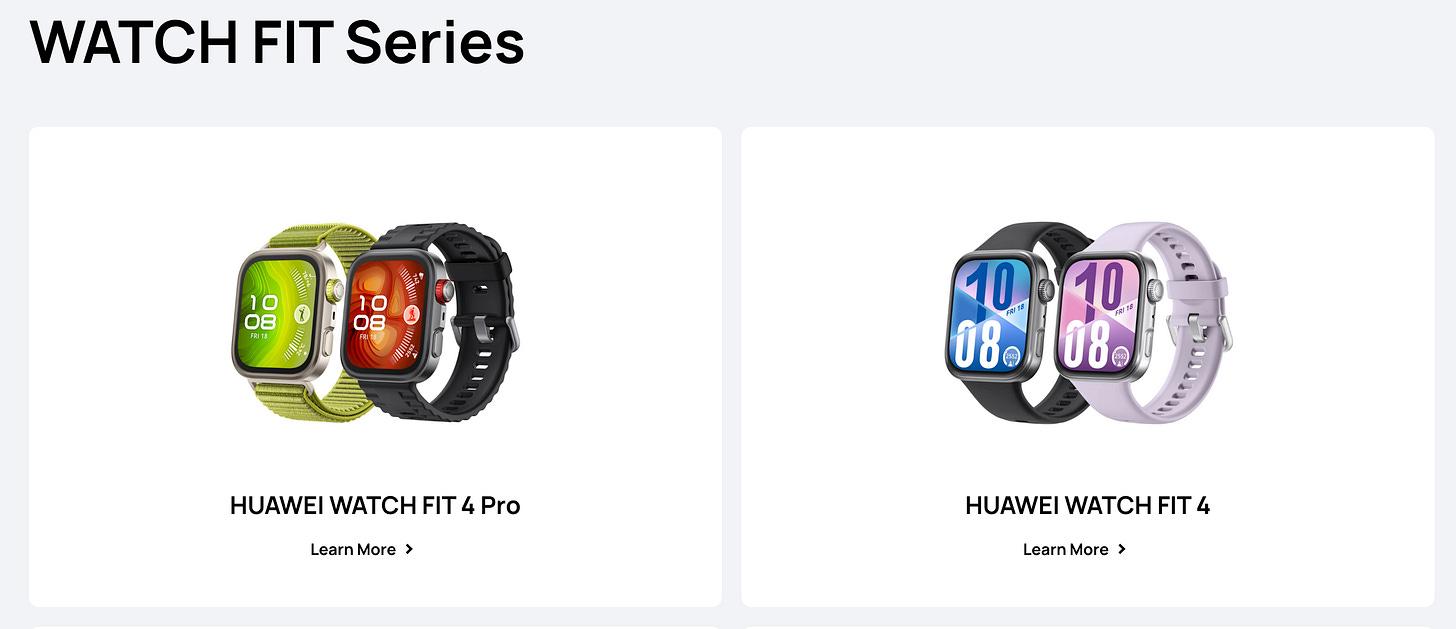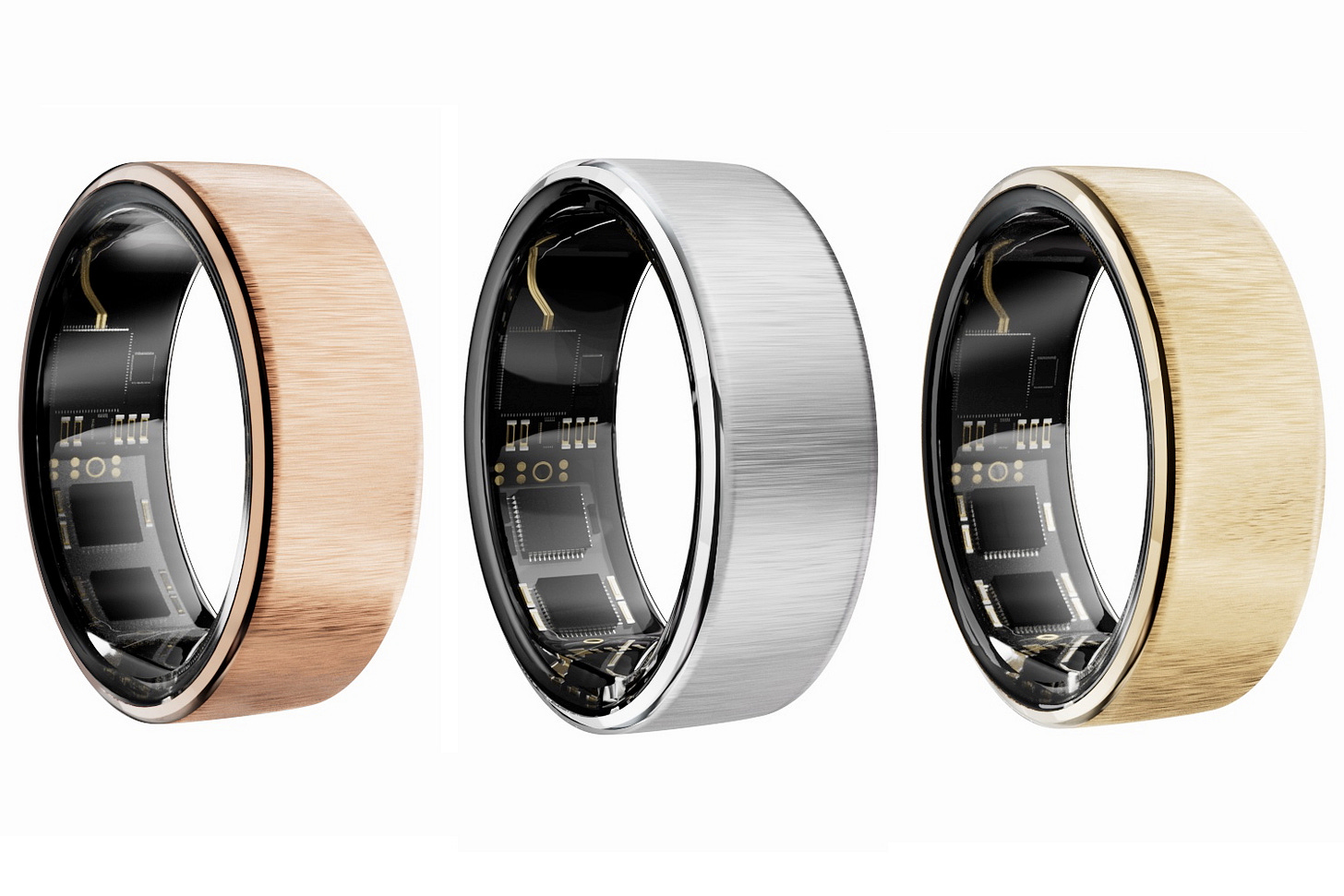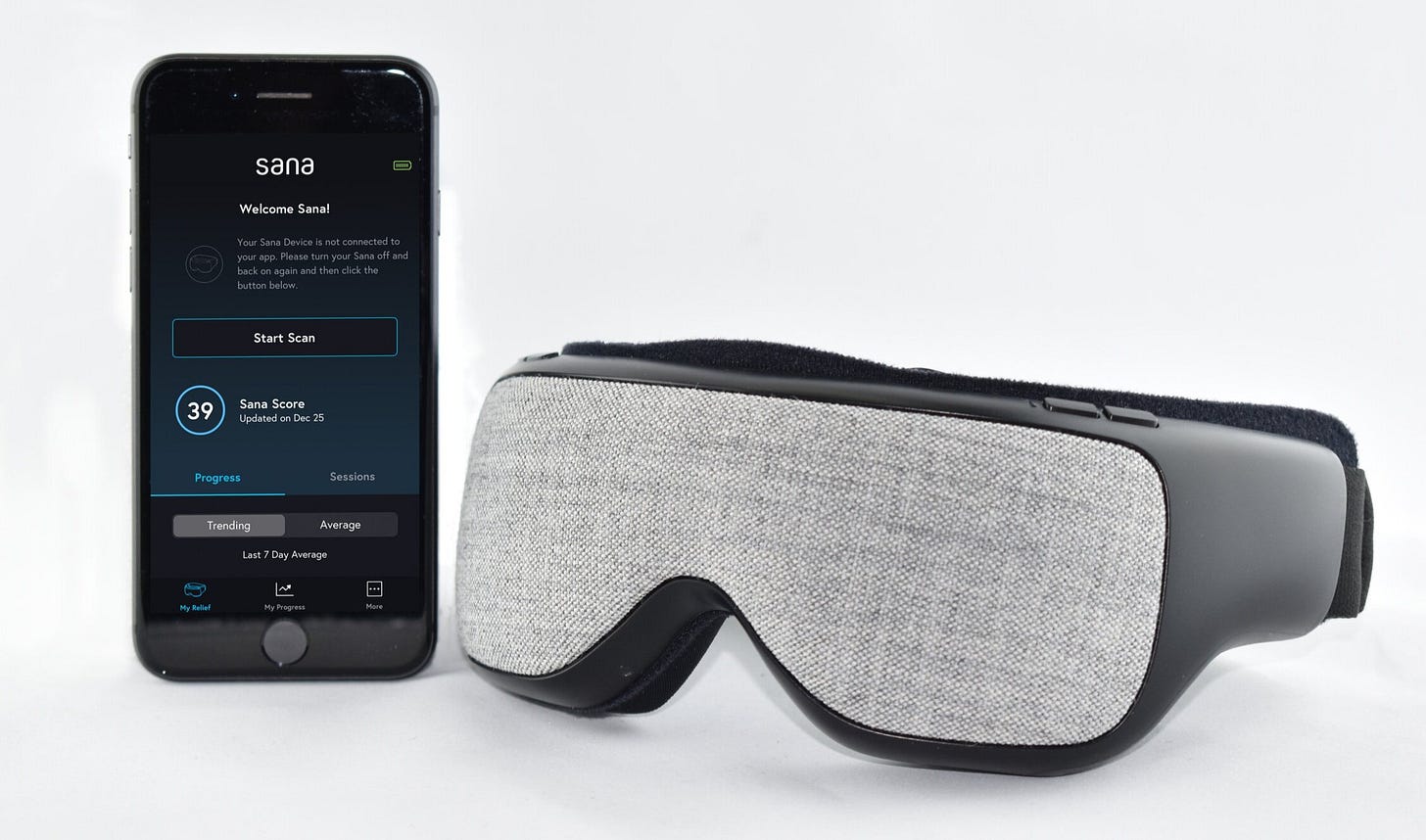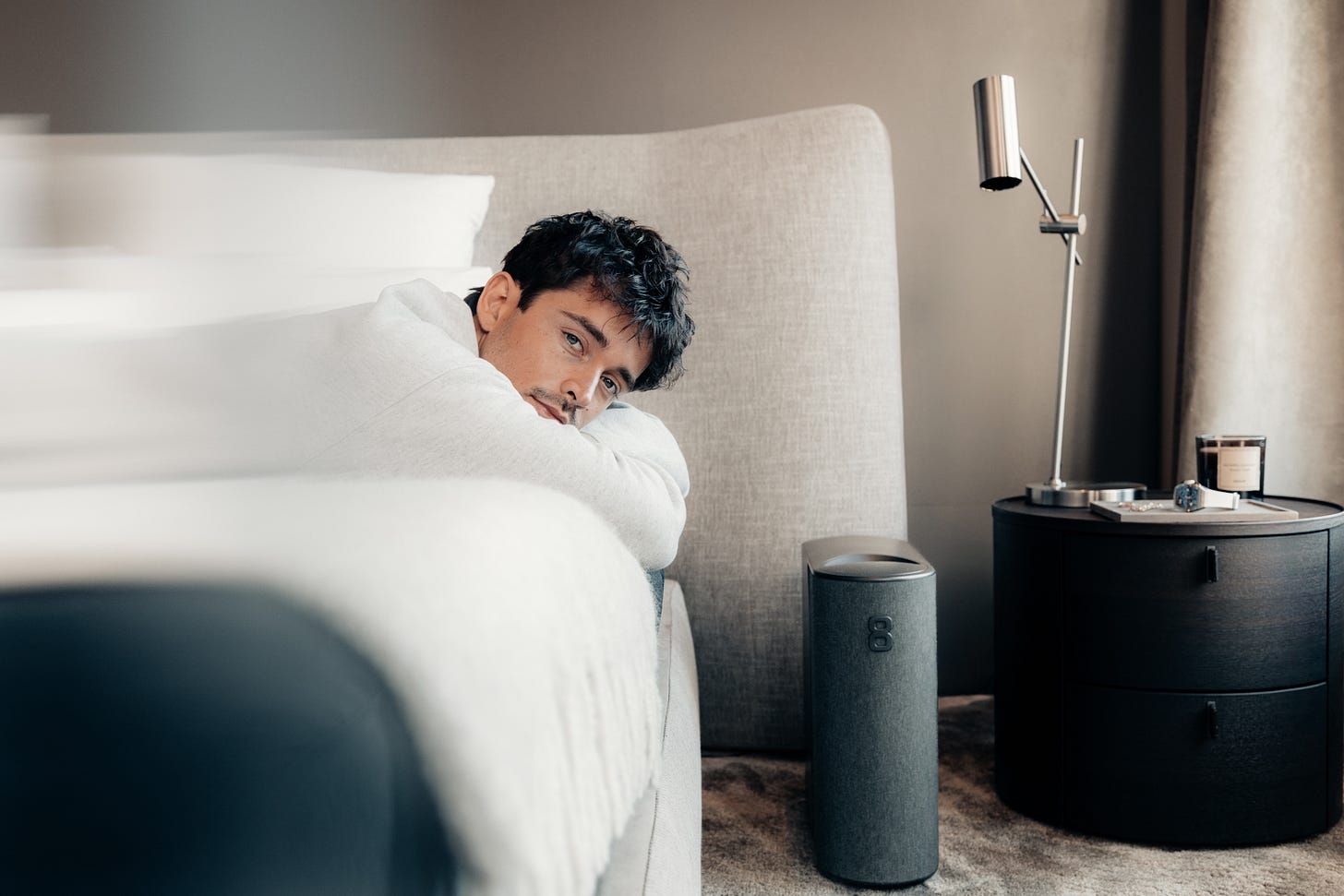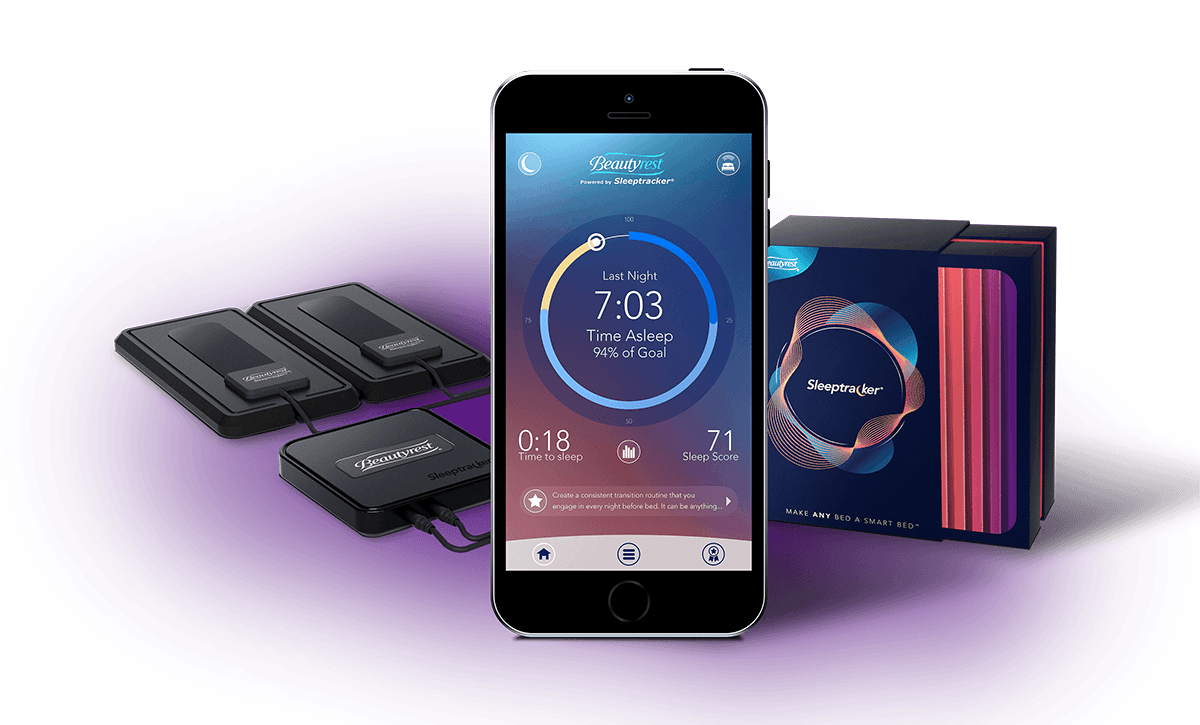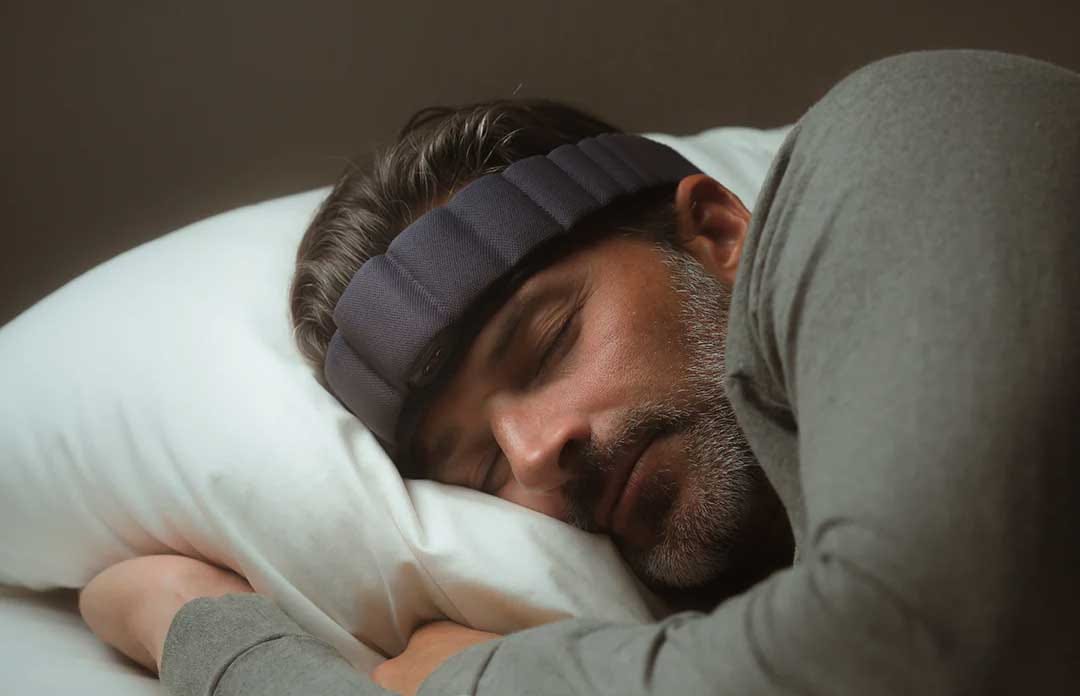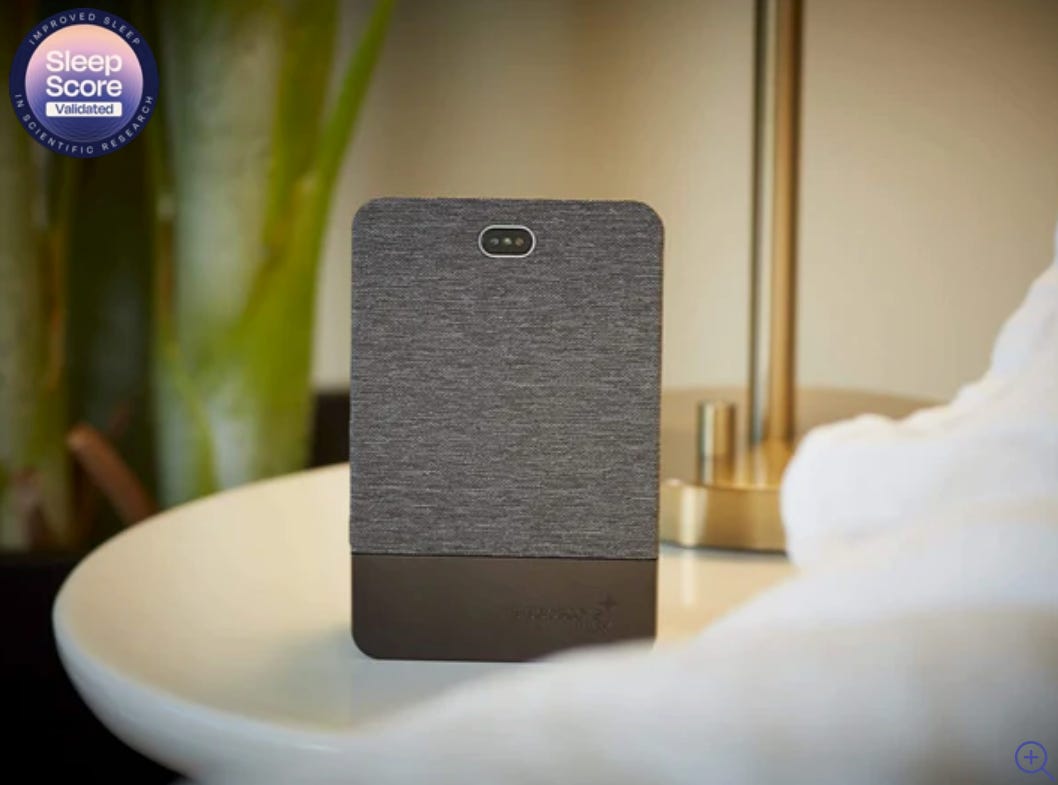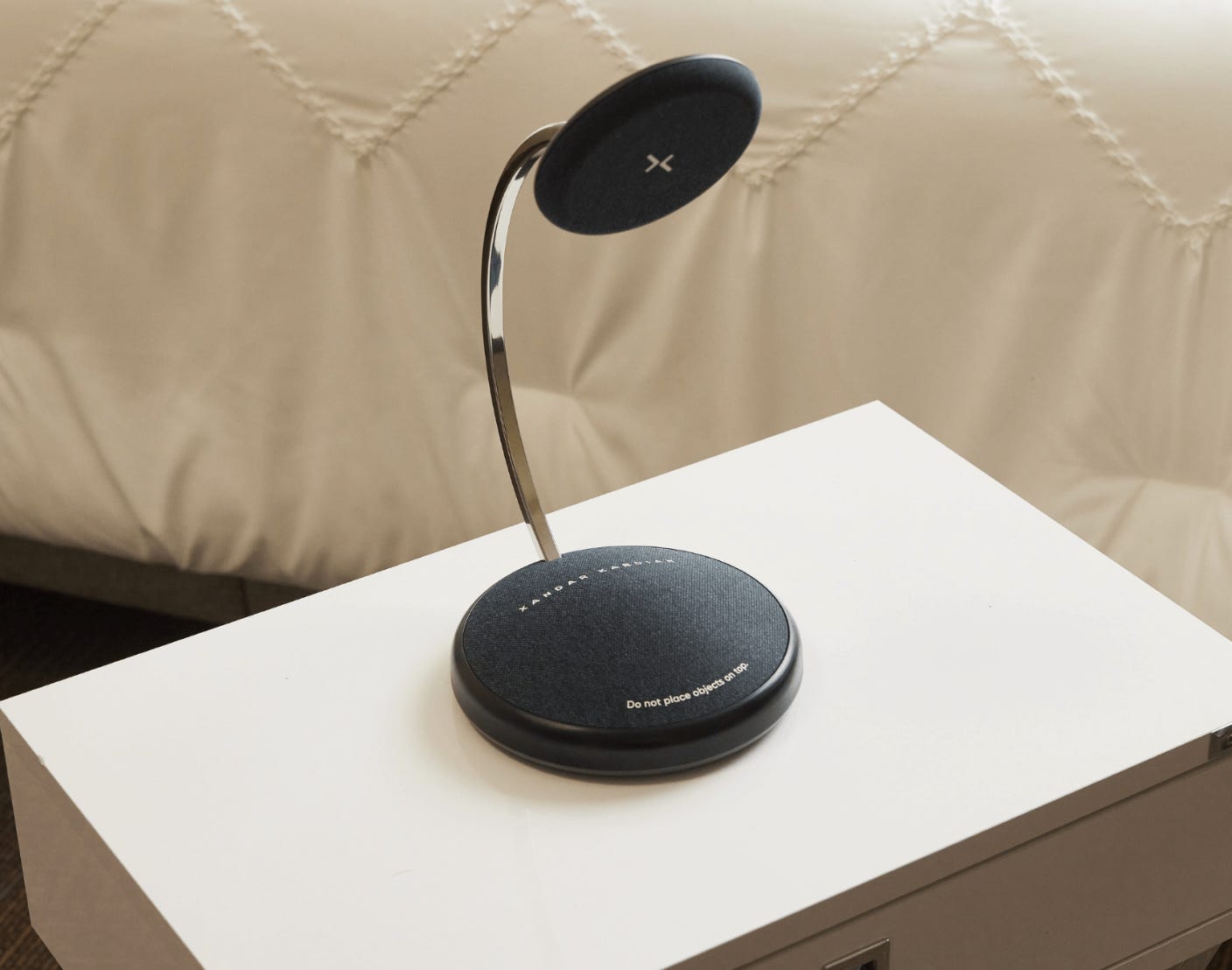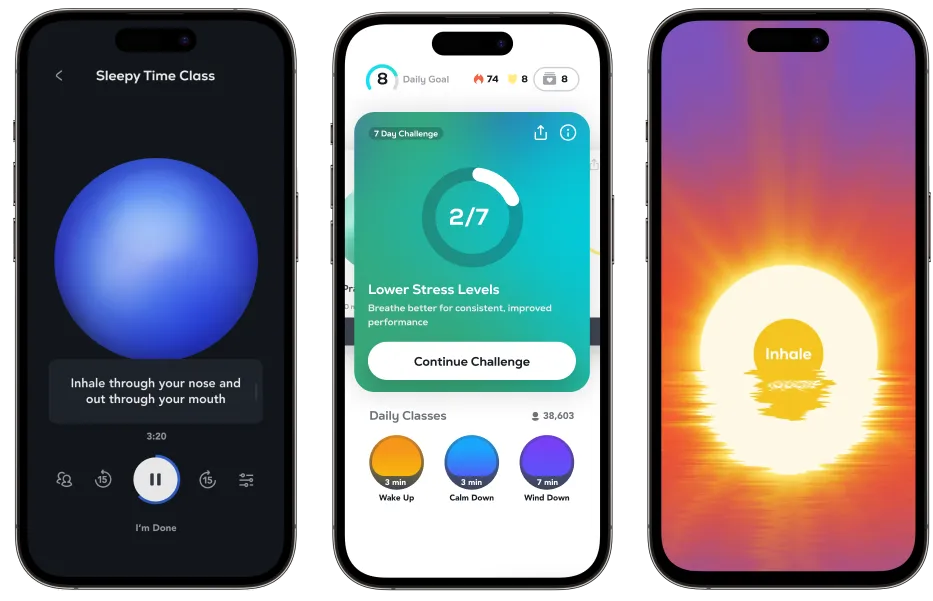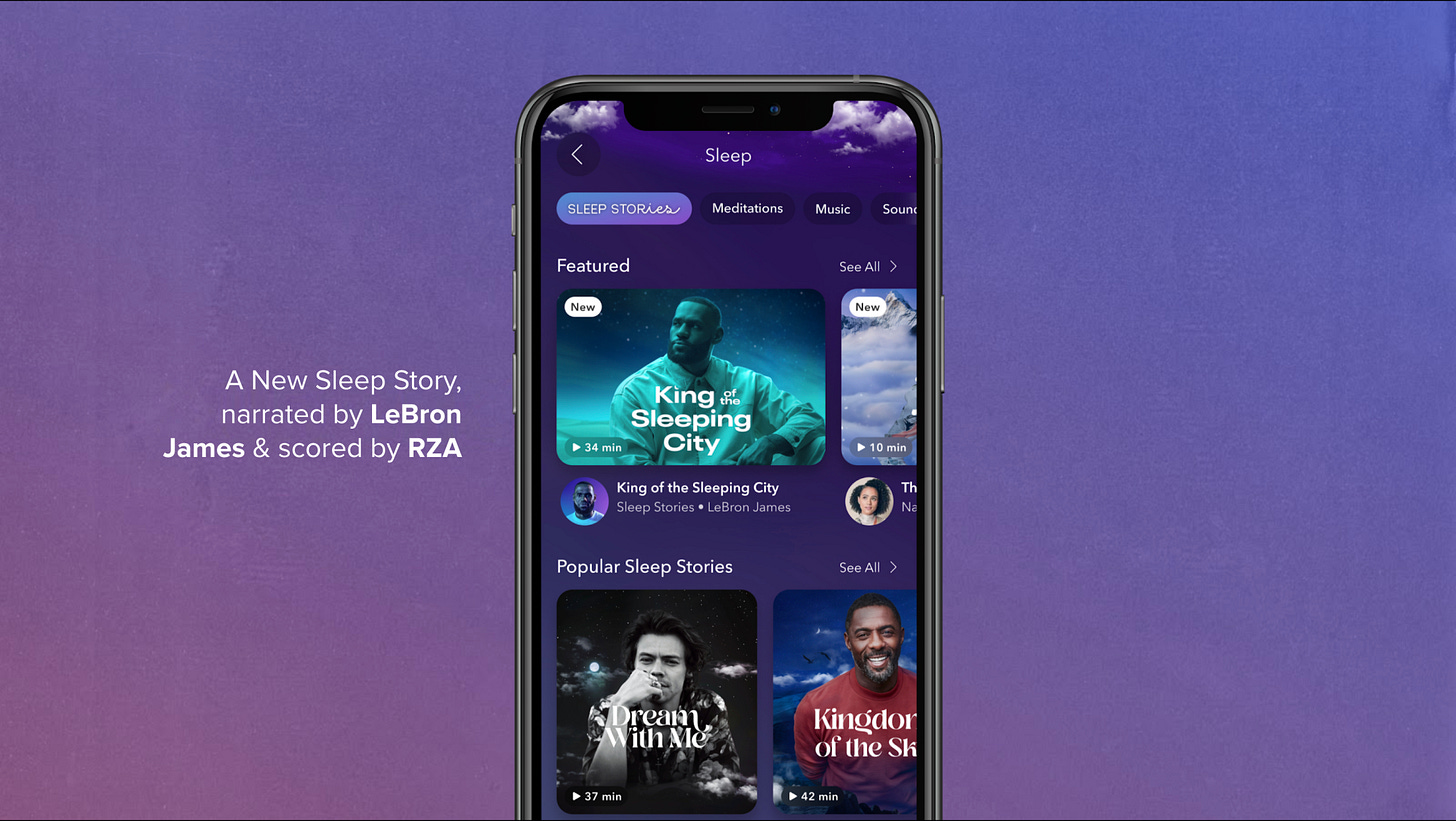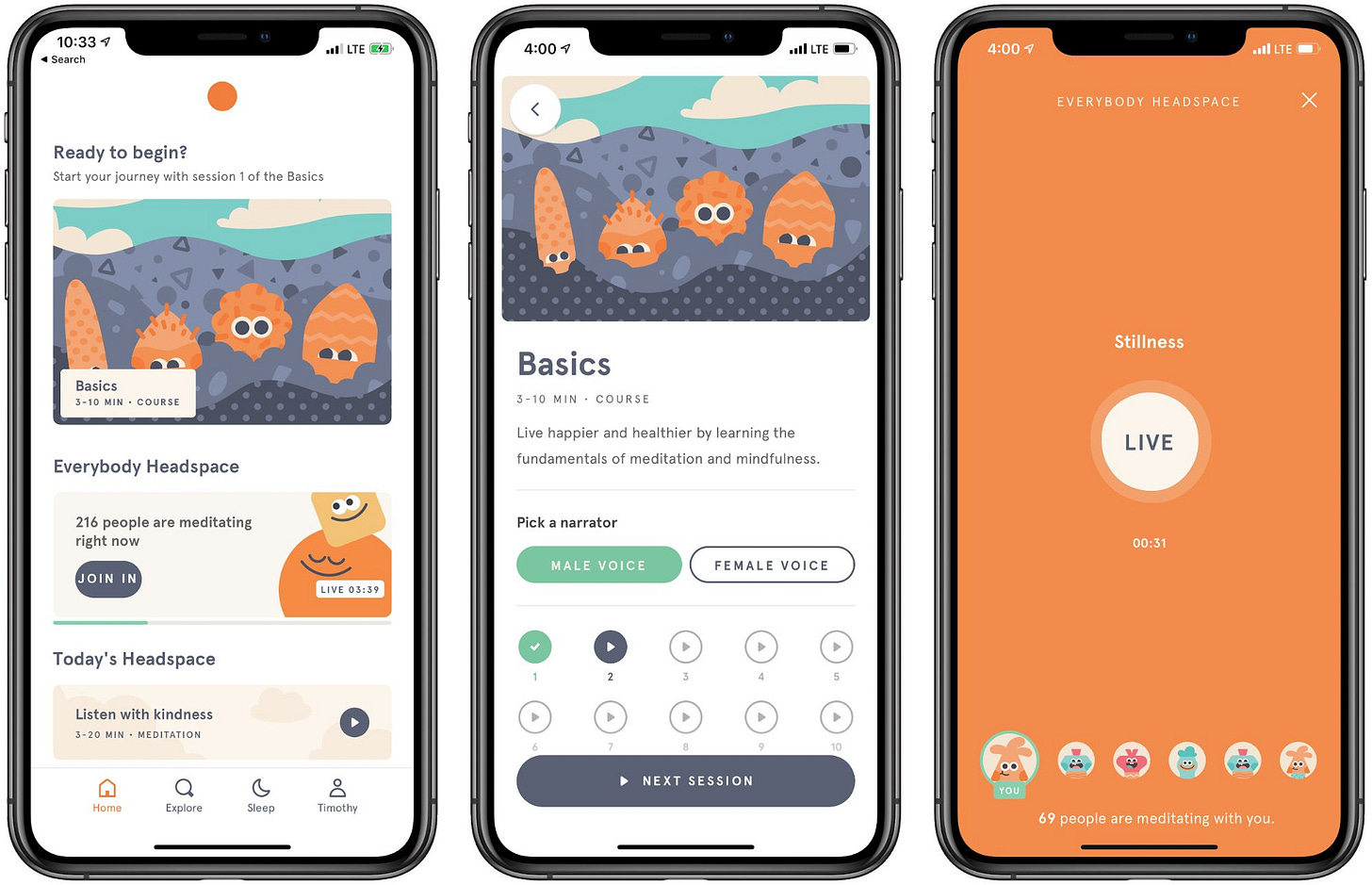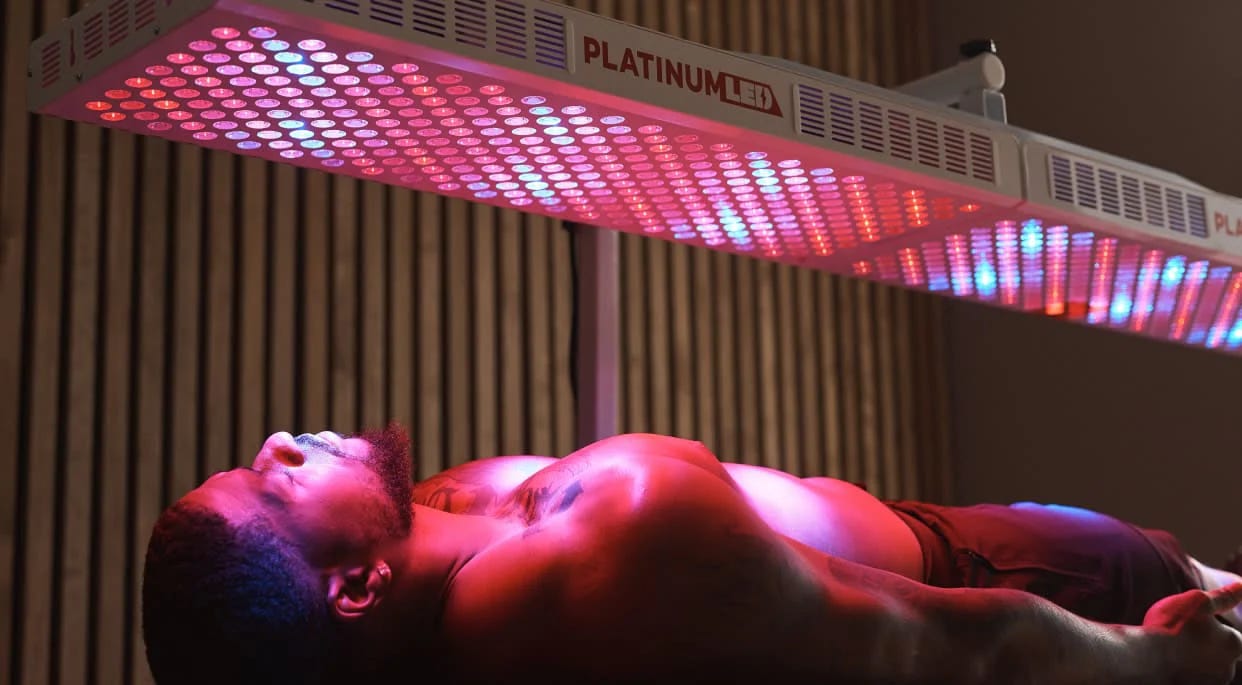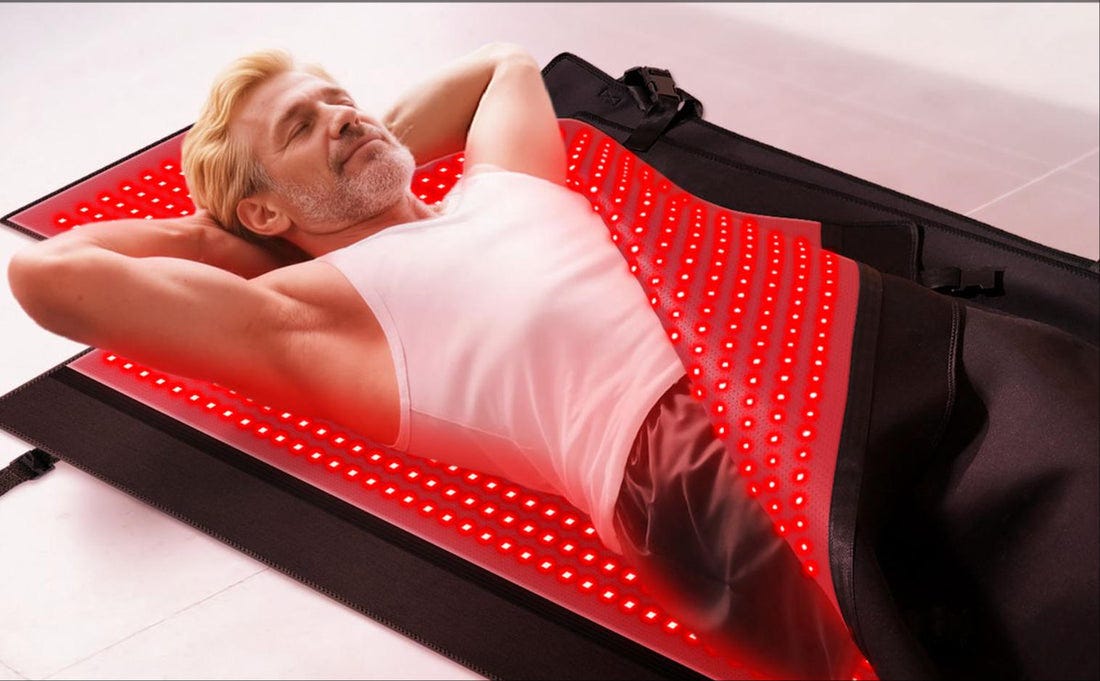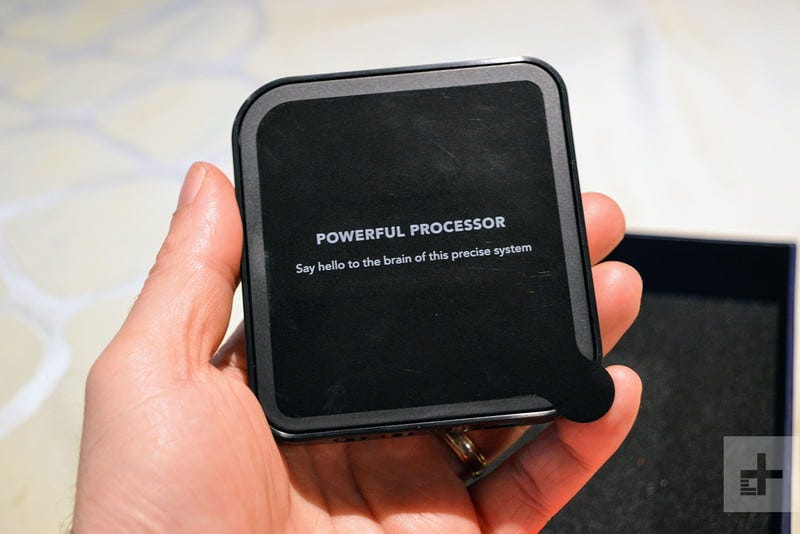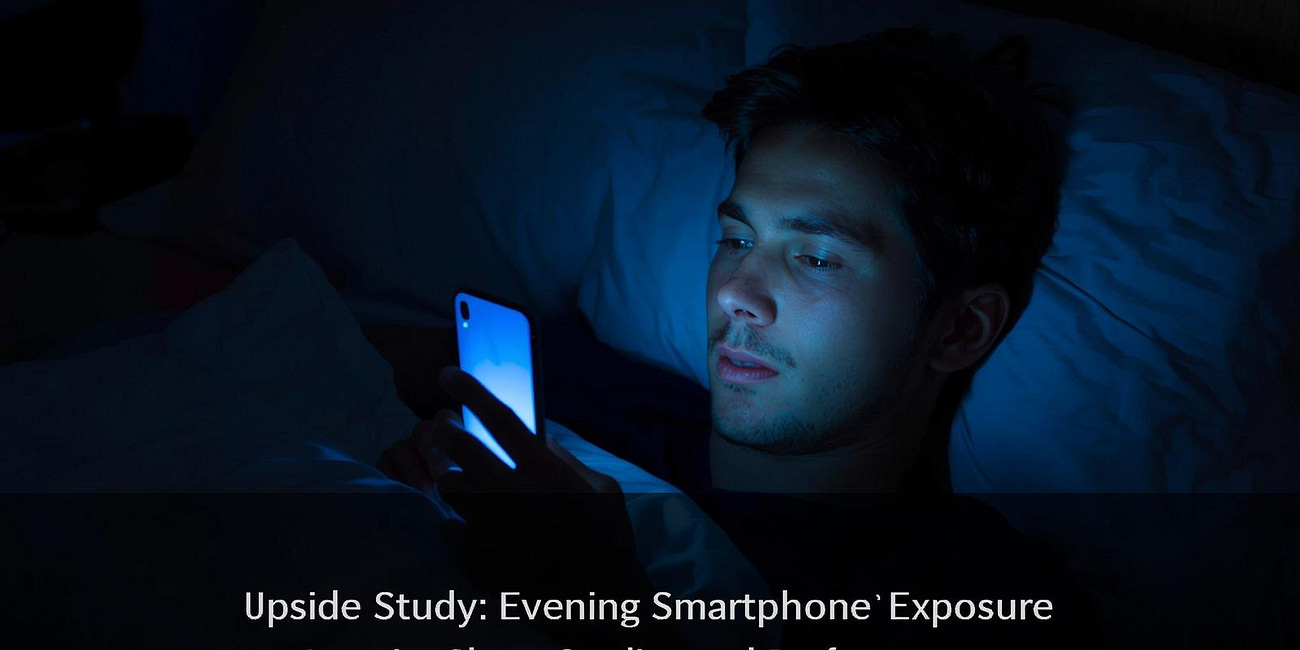💤 Upside Analysis: The Sleep Advantage: Mapping the Technologies, Science, and Strategies Powering Better Rest and Recovery in Elite Sports
Sleep is now treated as a core pillar of athletic preparation alongside training, nutrition and recovery. Teams and athlete-support staffs are investing in monitoring (to detect problems and guide scheduling) and in targeted interventions (sleep hygiene, behavioural therapy, devices and adjunctive therapies such as light therapy) to boost recovery, decision-making, injury resilience and on-field performance. Recent advances in wearables, headband/mask devices, algorithms and adjacent modalities (breathwork apps, red/near-infrared light therapy) are creating a practical — and commercially large — ecosystem for elite sport programs.
Market size
Estimates vary by report and by how “sleep tech” is defined (trackers only vs. full device + software market). Representative datapoints:
Global sleep-tech devices market was estimated ≈ $24.9B (2024) and multiple reports project high growth (CAGRs in the high teens) to 2030–2034 (e.g., projections to $68–135B depending on horizon and definitions). (Source: Global Market Insights)
Implication: the category is large, expanding rapidly, and attracting consumer and pro-sports investment (which pushes product maturity and B2B features useful for teams). (Source: Vogue Business)
Key use cases for teams & elite athletes
Sleep monitoring & readiness — continuous tracking of sleep quantity/quality to inform training loads, travel plans and player availability. (e.g., Oura, WHOOP used by teams/players).
Jet-lag & travel management — circadian scheduling, timed light exposure and melatonin guidance to accelerate adaptation on away trips.
Sleep extension & performance optimization — planned sleep extension blocks during lower-load periods to improve skill execution and reaction time. (evidence below).
Troubleshooting sleep disorders — screening for OSA, insomnia and circadian disorders with pathways to clinical care (tele-sleep clinics, PSG referrals).
Acute recovery aid — adjuncts such as red/NIR light therapy, breathwork and guided relaxation to speed recovery and improve sleep onset.
Why sleep is so important for athletes
Physical recovery & tissue repair: sleep (especially slow-wave sleep) supports protein synthesis, hormonal milieu (growth hormone pulses) and cellular repair. Poor sleep impairs these processes. (Source: PMC)
Neurocognitive performance: reaction time, decision-making, motor learning and skill consolidation are highly sleep-dependent; acute sleep loss degrades sprint times, accuracy and coordination. (Source: PMC)
Injury risk & immune resilience: chronic sleep restriction is linked to higher injury risk and worse immune function (slower recovery from infection/illness). (Source: PMC)
Mood & readiness: sleep quality influences motivation, perceived exertion, mood and ability to handle competitive stress. (Source: PMC)
“Sleep is one of the most important components in my opinion, for an athlete and here’s why. It’s also one of the most underutilized components. The reason why is that sleep not only effects the next day’s performance but it also has a big effect on the longevity of a pro or elite athlete. Here’s the key that every athlete, coach, trainer, sports exec, here’s what they need to know, that not all sleep is created equal. There’s much more to it than just getting your eight to nine hours of sleep”, said Annelise Thornton, the CEO of ETP systems, a company providing professional services in sleep recovery and performance to pro teams.
Picture: Chris Kaman sleeping during a game
Is there a correlation between sleep and the performance of an athlete?
“There’s a researcher out in California, her name is Cheri Mah and her research shows that by increasing team’s number of sleep hours by two hours a night, that that will have a direct benefit on the team’s performance. She worked with basketball players and swimmers, so the evidence is compelling for time in bed and number of hours of sleep, if you get two more hours of sleep. I think the basketball team increased their average sleep time by two hours a night and they improved their shooting by 19%, shooting accuracy and goals, something like that”, said Annelise Thornton, the CEO of ETP systems.
You can see our full interview with Annelise here
Main issues in the tech sleep monitoring market
Lack of clinical validations from sleep tech vendors: Many sleep tech vendors often make claims about what their sleep monitoring devices do or measure. Unfortunately many of these claims are not validated by clinical research, which is a concern for many athletic trainers. This is also the belief of sleep experts like Annelise Thornton, the CEO of ETP systems:
“I think it’s the Wild West, and that there are a lot of companies that are making claims that are not necessarily backed by clinical research”, said Mrs Thornton.
Privacy is a concern, especially for most athletes: Like with any trackers that are being worn on the body and track personal health, most athletes have a big perception that they are being tracked. With that in mind, privacy is a major concern for most athletes.
“There’s a lot of tech that’s out there that you can use to get daily information, but the risk of using let’s say wrist-based trackers is that there is a pretty big perception that that’s like Big Brother and Big Brother is always watching and they’re on top of you”, said Mrs Thornton.
How accurate are the various sleep trackers out there?
Most athletic trainers of pro teams often ask themselves: What are the most accurate sleep trackers out there today? Fullpower Technologies published a great analysis a few years ago that compares the accuracy of the measurements of various sleep trackers.
This study compared various sleep tech monitors such as Sleep IQ (Sleep Number) Resmed S+, Withings, Beddit Monitor 3.5 (Now part of Apple), SleepScore Max, the Fitbit Versa, Emfit QS, the Oura Ring, the Eight Sleep Mattress cover.
Then it compared those devices based on various criteria such as:
The level of accuracy compared to a polysomnography. 90% accuracy being very accurate.
Various insights provided: Daily sleep report email with coaching, automatic sleep detection.
The ability to support and monitor two sleepers.
The use of passive sensors, with no microphone, no cameras, no waves, nothing to wear on the body.
IOT cloud based, AI powered solution.
The ability to measure REM sleep
The form factor (invisible under the mattress).
The Integration with Google, Amazon or Apple smart home.
Always connected via home WiFi for reliable functionality
The FDA certification
Source: Fullpower Technologies
Overall Fullpower Technologies provided the most complete solution based on those criteria. For example its Sleeptracker® Monitor was 90% as accurate as polysomnography, which is considered as the gold standard. It can also monitor 2 sleepers, and can accurately differentiate one sleeper from the other. It can also provide actionable insights and personalized coaching. These are some of the key differentiators that make Fullpower Technologies stand up from the crowd in the market.
Key studies
Mah et al., 2011 — Sleep extension in collegiate basketball players (landmark experimental study showing improved sprint times, free-throw/3-point accuracy and reaction time after ~5–7 weeks of sleep extension to ~10 h/night). (Full study here)
Charest & Grandner, 2020 — Sleep and athletic performance: impacts on physical and cognitive outcomes (review summarizing sleep’s role across performance, recovery and health). (Full study here)
Systematic reviews (recent): Cunha et al., 2023 — systematic appraisal of sleep interventions in athletes (shows consistent benefit of sleep extension and targeted behavioral interventions). (Full study here).
Frontiers / 2025 review on sleep deprivation and sports performance — recent paper summarizing physiological and neuromuscular detriments from sleep loss and linking sleep to injury risk. (2025; useful for up-to-date synthesis). (Full study here).
Key vendors — comparison table
Now let’s talk about the key wearable sports segments:
(1) Smartwatch & fitness bands, rings: These are usually smart watches or fitness bands that can be worn on the wrist and that are capable of monitoring the athletes’ quality of their sleep, light sleep, deep sleep, etc. Companies focusing on this area include companies like Apple, Samsung, Xiaomi, Motorola, LG, adidas, Fitbit, Huawei, Fatigue Science, Whoop, to name a few. Companies like Oura or UltraHuman also built a smart ring that can measure sleep quality.
(2) Smart sleeping masks: This category usually includes smart masks that can help users relax and fall asleep. For example Sana built a smart sleeping mask that uses pulses of lights and sounds and can make athletes sleep in 15 minutes.
(3) Bed - sleep trackers: These are usually devices that are placed underneath the mattress and track and monitor the sleep quality of one or two individuals. Leading companies in the space include companies like Eightsleep, Fullpower Technologies, just to name a few.
(4) Headbands: These are usually headbands that can be worn on the head and that are capable of monitoring the athletes’ quality of their sleep, light sleep, deep sleep, etc. Companies focusing on this area include companies like Elemind, Somnee, just to name a few.
(5) Contactless biosensors based devices: These are typically devices that are embedded with a tiny radar (based on technologies like UWB) and advanced algorithms that can measure athletes’ biometric data (e.g. HR, sleep apnea, stress, anxiety, HRV, blood pressure, etc) without any contact to the skin. Leading players in the space include companies like SleepScore, Circadia Tech, and Xandar Kardian.
(6) Relaxation apps: These are mobile applications that use guided Calm, mindfulness, and relaxation exercises to help athletes manage stress, enhance recovery, and improve sleep quality. Leading players in the space include companies like Breathwrk (recently acquired by Peloton), Calm, Headspace.
(7) Red light therapy devices: These are devices (mat, bed side devices..) using red light therapy stimulating natural melatonin to help athletes fall asleep. Key vendors includes companies such as HigherDOSE, Helight, Joov, PlatinumLED, Mito Red Light, just to name a few.
(6) Professional services: These are typically companies who work with sports teams to help athletes better manage and improve their sleep. These companies essentially assess, and optimize athletes’ sleep quality. Leading companies in this space include companies like Dreem Health.
Here is a table summarizing the various vendors:
Source: Upside Global, 2025
Smartwatch & fitness bands, rings
Apple Apple Watch offers comprehensive sleep tracking, including stages like REM, Core, and Deep, along with heart rate and respiratory rate data. The Sleep app allows users to create personalized sleep schedules and utilize “Sleep Focus” to minimize distractions and optimize their bedtime routine. With the integration into the Health app, users can view their sleep trends and even track metrics like nightly wrist temperature.
The Apple Watch is extensively utilized across the professional sports landscape, including the MLS, NFL, MLB, NBA, NHL, and the Premier League‘s wider ecosystem. The MLS, in particular, has a deep partnership with Apple, which involves providing a global streaming service and allowing teams like LAFC to integrate the Apple Watch with third-party apps for training and remote player health monitoring. While the NHL uses a custom Apple Watch app for on-ice official communication, the watch is also key for fans in the other major leagues, delivering real-time scores and stats via Live Activities through the Apple Sports app. To learn more go here.
Samsung Samsung’s Galaxy Watch and Galaxy Ring use the Samsung Health app to provide detailed sleep analysis, including a daily sleep score, sleep stages, and in-depth sleep coaching programs. Advanced features include blood oxygen monitoring during sleep and snoring detection, with the newest models offering analysis for signs of sleep-related breathing disorders like sleep apnea. The platform integrates with the SmartThings app, allowing users to automatically control smart home devices for an optimal sleeping environment.
Samsung’s official involvement in professional sports is centered on new, innovative leagues, heavily featuring both the Galaxy Watch and the Galaxy Ring for data tracking. The Unrivaled women’s 3-on-3 basketball league is Samsung’s key partner, equipping all players with both the Galaxy Watch and Ring to monitor performance, recovery, and holistic health metrics for both the athletes and coaching staff. Samsung also strategically utilizes the Galaxy Ring to track the readiness of extreme sports athletes, such as those at Red Bull Rampage, integrating the health data into their high-performance training and recovery routines. To learn more go here.
Xiaomi Xiaomi’s Smart Bands provide 24-hour sleep monitoring, automatically detecting sleep status to record both long sleep sessions and short sporadic naps. The data, viewable in the companion app, includes total sleep time and the duration of awake, light, and deep sleep stages, with newer models tracking REM sleep. You can explore the features of Xiaomi’s latest Smart Bands on their global product pages. To learn more go here.
Motorola Motorola’s Moto Watch line offers intelligent sleep tracking in its wearables to help users rest smarter by night. The devices monitor sleep duration, break down time spent in Awake, Light, REM, and Deep sleep phases, and report SpO2 levels for comprehensive nocturnal insights. Through the Moto Watch App, users can view their sleep depth and a calculated sleep quality score. To learn more go here.
LG LG is primarily focused on integrating sleep technology into its smart home ecosystem through a partnership with the South Korean startup Asleep Inc. The goal is to develop home appliances that can automatically adjust to a user’s sleep stage, detected non-invasively by analyzing breathing sounds via smart devices like TVs and speakers. This allows for automated actions, such as changing an air conditioner’s temperature or a bedroom air purifier’s mode, to optimize the sleep environment. To learn more go here.
adidas Adidas’s involvement in the sleep and recovery space has recently focused on the “Relaxation apps” category through a partnership with Calm. The collaboration aimed to progress sports performance through mental wellbeing by offering its members access to Calm Premium and specially tailored content. While the brand has historically been involved in wearables, its recent sleep strategy centers on mental fitness to help athletes “Rest. Restore. Perform.” To learn more go here.
Fitbit Fitbit, now part of Google, is a key player in wearable technology, offering a line of smartwatches and activity trackers that monitor heart rate, physical activity, and sleep quality. The devices break down sleep into stages and provide a Sleep Score for an overview of the night’s rest. Fitbit continually works on integrating advanced features like SpO2 and nightly temperature variations to give users deeper insights into their overall health and recovery. To learn more go here.
Huawei Huawei’s watches and bands utilize its own technology, such as HUAWEI TruSleep™, to provide detailed sleep monitoring. The wearables automatically record sleep duration and identify various sleep phases, including deep, light, and REM sleep. Users can also enable a Sleep Mode to automatically silence notifications and disable the “Raise to wake” feature for an uninterrupted night of rest. To learn more go here.
Fatigue Science Fatigue Science is a professional services and technology company that provides predictive fatigue risk management solutions for industrial, mining, and transportation companies, and professional sports teams. Their platform analyzes sleep data, optionally gathered from a wearable device, to predict the effect of sleep disruption on cognitive effectiveness and reaction time. This predictive data allows supervisors to optimize shift schedules and assign critical tasks when employees are least fatigued, enhancing both safety and performance.
Fatigue Science’s predictive fatigue monitoring platform, which uses wearable technology like the Readiband, is widely adopted across numerous professional leagues to optimize player performance and safety. Sports teams in major North American leagues, including the NFL (e.g., Seattle Seahawks, Houston Texans), MLB (e.g., Chicago Cubs, Seattle Mariners), NBA (e.g., Dallas Mavericks), and NHL (e.g., Pittsburgh Penguins, St. Louis Blues), are among their prominent clients. The technology leverages an Army-developed biomathematical model to analyze sleep data and predict an athlete’s mental effectiveness and readiness, helping coaching staff make data-driven decisions on training, travel, and scheduling. To learn more go here.
Oura Oura is a health technology company that manufactures a wellness wearable in a ring form factor, which tracks and improves sleep and overall performance. The Oura Ring is worn 24/7 to monitor key physiological parameters, including sleep stages, heart rate variability (HRV), and body temperature. This data is translated into daily Sleep, Activity, and Readiness scores to provide actionable insights for maximizing health and recovery.
The Oura Ring is widely used in professional sports, with several major leagues and organizations adopting the smart ring to monitor player health, sleep, and recovery. Leagues that have partnered with Oura include the NBA, WNBA, NASCAR, and the UFC Performance Institute. Additionally, individual teams like Real Madrid, the Seattle Mariners, and the New York Knicks utilize the device to gain valuable insights for performance optimization. To learn more go here.
UltraHuman Ultrahuman develops the Ring Air, a compact, lightweight smart ring for real-time tracking of sleep, movement, and recovery. The ring’s sensors accurately measure skin temperature, heart rate, and heart rate variability (HRV) from the finger, a site with high blood flow. This data powers daily Sleep and Recovery scores, along with insights designed to help users optimize their metabolic health and training performance.
The Ultrahuman Ring is utilized by elite teams in endurance and winter sports who prioritize in-depth recovery and sleep tracking. The most prominent users are UCI WorldTour cycling teams like UAE Team Emirates XRG (featuring Tour de France champion Tadej Pogačar) and the USA Bobsled/Skeleton team, all of whom use the Ring AIR to meticulously analyze HRV, sleep, and recovery to optimize their training loads. The wearable is also used by soccer clubs such as Chennaiyin FC in the Indian Super League to enhance player welfare and on-pitch performance. In the MLS, CF Montreal is among the latest MLS teams to have adopted the Ultrahuman smart ring. To learn more go here.
Smart sleeping masks
Sana Sana developed a smart sleeping mask designed to help users relax and fall asleep quickly by using synchronized pulses of light and sound. The therapeutic wearable is built on over 20 years of clinical research and works by measuring the user’s heart rate variability (HRV) to tailor the audio-visual stimuli. The goal of the non-invasive device is to increase balance between the brain’s hemispheres, which can alleviate sleep problems related to chronic pain and PTSD, making users fall asleep, on average, in under ten minutes. To learn more go here. You can also check out interview with Sana CEO here.
Bed - sleep trackers
Eightsleep Eight Sleep is a sleep technology company whose mission is to fuel human potential through optimal sleep by leveraging advanced thermoregulation. Their core product, the Pod Cover, uses integrated bio-tracking sensors and a dynamic heating and cooling system to automatically maintain the perfect temperature for each sleeper. The system tracks sleep quality metrics and adjusts the bed’s temperature throughout the night to improve deep sleep and overall restfulness.
Eight Sleep’s specialized smart mattress cover, The Pod, is a premium sleep optimization tool utilized by over 300 individual professional athletes and several high-performance teams. In Formula One, the technology is used by the Mercedes-AMG Petronas Formula One Team and by Ferrari driver Charles Leclerc, who is also an ambassador and investor, to manage fatigue and recovery during the grueling travel schedule. Beyond F1, the Pod is relied upon by endurance teams like EF Education-EasyPost cycling and individual stars in major North American leagues, including the NFL’s Brock Purdy, NBA’s Jimmy Butler, and MLB’s Aaron Judge.To learn more go here.
Picture: Ferrari driver Charles Leclerc
Fullpower Technologies Fullpower Technologies is a privately held developer and licensor of cloud-based IoT and wearable technology, notably specializing in its Sleeptracker® technology for non-wearable sleep monitoring. Their solutions, often integrated into mattresses or under-mattress devices, use patented AI algorithms to monitor two individuals simultaneously, capturing data on sleep stages and snoring. The platform provides a customized sleep report and personalized tips to help manufacturers offer a smart bed that dynamically improves the user’s rest. To learn more go here.
Headbands
Elemind Elemind is pioneering electric medicine by developing a wearable neuromodulation technology that can non-invasively influence brain activity. While their technology has broad applications, including memory and pain, their first consumer focus is on sleep, developing a device capable of monitoring and intervening in brain rhythms. The goal is to provide a wearable neurotechnology that can safely and effectively optimize the user’s natural sleep and cognitive functions. To learn more go here.
Somnee Somnee created a smart sleep headband that leverages lab-grade electroencephalogram (EEG) sensors and proprietary AI to provide gentle, personalized neurostimulation. The device is designed to be worn all night to track sleep and deliver a 15-minute stimulation session at bedtime that nudges the brain toward deeper, more restorative sleep. The company’s unique approach moves beyond passive tracking to actively improve sleep quality for peak cognitive performance.
Somnee has a deep relationship with the NBA, having been selected for the league’s 2025 Launchpad program and subsequently receiving a follow-on investment from the NBA itself. The Somnee smart sleep headband, which uses EEG sensors and AI neurostimulation, was pilot-tested by select NBA and WNBA teams and staff, showing positive results in improving sleep quality and duration for recovery. This unique partnership positions Somnee as a performance-enhancing tool designed to actively “tune” sleep for the elite athletes and high-performance personnel within the basketball community. To learn more go here.
Contactless biosensors based devices
SleepScore SleepScore, powered by SleepScore Labs, is a sleep monitoring and improvement platform that uses non-contact, sonar technology in a smartphone app or bedside device to measure sleep. The patented technology tracks micro-movements and breathing rate to analyze sleep cycles, including time spent in light, deep, and REM sleep, with accuracy validated against clinical standards. The platform then uses this data to deliver a daily SleepScore and personalized, science-backed advice to help users improve their rest. To learn more go here.
Circadia Tech Circadia Health provides an FDA-cleared, contactless patient monitoring platform primarily for professional healthcare settings like skilled nursing and long-term care facilities. Their C200 device uses Ultra-Wideband (UWB) radar technology to continuously track a patient’s vital signs—specifically respiratory rate, heart rate, and bed exits—from up to eight feet away without requiring a wearable. The system utilizes predictive AI analytics, like the Probability of Change in Condition (POC) Score, to detect signs of health deterioration up to 72 hours early, allowing for proactive intervention. To learn more go here.
Xandar Kardian Xandar Kardian specializes in UWB radar-based biosensor technology to autonomously monitor human health and the built environment. Their medical device, the XK300, is the world’s first and only FDA 510(k)-cleared Class II medical device to non-invasively and continuously monitor motion, resting heart rate, and respiratory rate from a distance. By sensing micro-vibrations from the body through materials like clothing and drywall, the technology provides highly reliable, privacy-compliant vital signs monitoring for healthcare and residential settings. To learn more go here.
Relaxation apps
Breathwrk Breathwrk, recently acquired by Peloton, is a leading mobile application dedicated to improving mental and physical wellbeing through science-backed breathing exercises and guided classes. The app’s extensive library includes specific protocols, such as the 4-7-8 technique, designed to activate the parasympathetic nervous system for sleep and stress relief. By providing customizable sessions with haptic feedback and music, Breathwrk offers a simple, drug-free tool to help athletes and general users manage stress, increase focus, and fall asleep quickly.
The NBA is the key professional league linked to the Breathwrk app, having selected the company for its Launchpad program which evaluates technologies for athlete performance. The science-backed breathing exercises are frequently recommended by NBA coaches and mental health experts to help athletes manage stress, improve focus, and enhance sleep for a competitive advantage. Although there are no specific team partnerships announced, the app is widely adopted by individual elite athletes and is now integrated into the larger Peloton wellness platform. To learn more go here.
Calm Calm is a global leader in mental wellness, primarily known for its mobile application that offers guided meditations, narrated Sleep Stories, and mindful movement sessions. The platform focuses on the holistic practice of mindfulness and relaxation exercises to help users manage stress, improve focus, and ultimately enhance sleep quality. Its Sleep Stories, voiced by soothing narrators, have become a signature feature, helping millions of people worldwide wind down and drift off to sleep.
Calm is the Official Mindfulness and Meditation Product of FIFA, providing free subscriptions to all players, coaches, staff, and volunteers for major tournaments including the FIFA Men’s and Women’s World Cups. At the collegiate level, the app is a resource for all student-athletes, coaches, and staff across major bodies like the ACC, Big Ten, and Pac-12 Conferences as part of their mental health initiatives. Individual athletes, including LeBron James, and specific teams, such as the Houston Astros‘ minor league organization, have also partnered with Calm to utilize its meditation and sleep content for focus and recovery. To learn more go here.
Headspace Headspace is a digital mental health platform dedicated to making mindfulness and meditation accessible to everyone, no matter their background or experience. The flagship app offers a wide range of tools, including guided meditation courses, “Sleepcasts” for a restful bedtime, and mindful movement exercises. By teaching users techniques for stress management and cognitive training, Headspace helps create the mental conditions necessary for deep, restorative sleep.
Headspace has established significant multi-year partnerships with multiple North American sports leagues to promote mental wellness and performance. The app is an official resource for all athletes, coaches, and staff across Major League Soccer (MLS), U.S. Soccer (including the Men’s and Women’s National Teams), and the NBA (including the WNBA and G League). High-profile individual athletes, including English Premier League footballer Raheem Sterling, have also partnered with Headspace to develop content and champion the mental benefits of the app for competition readiness and focus. To learn more go here.
Red light therapy devices
HigherDOSE HigherDOSE is a beauty and wellness brand that focuses on promoting detoxification and relaxation, and is well-known for its line of infrared products, including the Infrared Sauna Blanket. While primarily known for deep heat and detox, their products, such as various red light devices, leverage the therapeutic benefits of near- and far-infrared light to support the body’s natural recovery processes. Red light therapy is used by athletes and wellness enthusiasts to stimulate cellular repair and enhance rest.
HigherDOSE products, including the Infrared Sauna Blanket and various red light devices, are widely used by individual professional athletes and have a significant presence within the NBA ecosystem. Specifically, the Knicks basketball program is cited as using infrared therapy as a recovery weapon for their players. Although HigherDOSE does not hold an official league-wide partnership, its focus on cellular recovery and detoxification makes its devices popular among high-performance personnel across several major sports. To learn more go here.
Helight Helight is the developer of Helight Sleep, a patented, bedside sleep aid device that diffuses a pure red light calibrated at 630 nanometers. Inspired by NASA research, the device uses a 28-minute protocol where the light gradually fades out, a process designed to signal the body to relax and naturally promote melatonin production. Helight aims to provide a non-addictive, natural, and scientifically based solution to help users fall asleep faster and achieve deeper, more restful sleep.
Helight is a trusted sleep aid used by professional athletes and sports professionals across multiple major leagues, particularly those dealing with demanding travel schedules. Its patented, sunset-mimicking red light protocol is employed by individual players and staff from leagues including the MLS (e.g., CF Montreal), NHL teams, and Premier League players. The device is highly valued by certified athletic therapists, who use it to help athletes naturally enhance sleep quality, mitigate jet lag, and accelerate physical recovery. To learn more go here.
Joovv Joovv is a major manufacturer of powerful, full-body red and near-infrared light therapy devices for at-home use. The company’s mission is to optimize human health by harnessing the therapeutic power of light, with devices frequently used by professional athletes and health practitioners for recovery. While applications are broad, including muscle recovery and skin health, red light therapy is known for its systemic benefits, which include stimulating melatonin for improved sleep.
Joovv is the Official Light Therapy Partner of the San Francisco 49ers in the NFL, having integrated a dedicated Joovv Recovery Room into Levi’s Stadium for player use before and after games. The technology is widely used by individual athletes across the NBA (including stars like Mo Bamba and trainers for the Knicks), MLB (pitcher Matt Boyd), and the PGA Tour for optimizing recovery and performance. Athletes and teams rely on the full-body red light therapy to reduce inflammation, aid in injury recovery, and enhance sleep quality, particularly due to the demands of rigorous travel and training schedules.To learn more go here.
PlatinumLED PlatinumLED Therapy Lights manufactures powerful, medical-grade red and near-infrared light therapy devices (panel, mat), particularly their BIOMAX series panels. The company’s solutions are used by athletes and wellness enthusiasts to aid in muscle recovery, reduce pain, and improve overall health, with devices often qualifying as HSA/FSA-eligible for therapeutic use. The systemic benefits of their high-irradiance light therapy can positively influence the body’s sleep and recovery cycles.
PlatinumLED Therapy Lights are widely used by professional athletes and elite organizations for accelerated recovery, though the company does not currently list official league-wide partnerships. The company’s high-irradiance BIOMAX panels are utilized to aid in muscle recovery, reduce pain, and enhance sleep, supporting athletes in intense disciplines like the NHL (e.g., Pavel Francouz) and Olympic sports. PlatinumLED products are recognized for their clinical-grade power, making them a preferred device in high-performance training rooms and the homes of individual athletes focused on deep physiological recovery. To learn more go here.
Mito Red Light Mito Red Light designs, engineers, and manufactures cutting-edge red light therapy devices, including their MitoPRO series, which utilize multiple bioactive red and near-infrared wavelengths. The company focuses on maximizing the power and effectiveness of their products to increase mitochondrial energy production within cells. These devices are utilized for general wellness purposes to support cellular health, which is a foundational element in improving sleep quality, stress management, and overall vitality.
Mito Red Light has established partnerships with professional sports organizations, most notably with the NHL’s Arizona Coyotes, who utilize large and small Mito Red panels in their “Recharge Room” for recovery, pain management, and optimizing player readiness. The devices are also used by individual athletes in major leagues, including NHL goalie Pavel Francouz (Colorado Avalanche), NFL cornerback Garrett Williams, and World No. 2 tennis player Ons Jabeur. These elite individuals and teams rely on the multi-wavelength red light therapy for expedited muscle recovery, reduced inflammation, and general cellular health, which is vital for performance. To learn more go here.
Professional services
Dreem Health Dreem Health is a digital sleep clinic that works to fix the broken sleep care patient journey by connecting individuals with sleep specialists through a streamlined telehealth platform. Managed by the Sunrise Group, the company focuses on diagnosing sleep disorders using home-based tests and delivering effective, easy-to-follow treatment plans. Their services essentially assess and optimize an athlete’s sleep quality by providing professional clinical assessment and personalized care. To learn more go here.
Future trends
Stronger clinical integration: tele-sleep clinics and remote PSG alternatives will let teams route athletes from screening to care faster.
Fusion of data streams: sleep + HRV + glucose/biomarkers + travel schedules → more accurate individualized readiness models (AI-augmented). Oura and other vendors are investing in AI and broader sensing.
Targeted neuromodulation for sleep onset/quality: audio/EEG closed-loop stimulation in masks/headbands — more real evidence is emerging.
Adjunct therapies as routine recovery tools: red/NIR light therapy and guided breathwork will be more commonly integrated into pre-sleep and recovery routines (with formalized dosing protocols).
Privacy & data governance focus: with player biometric data, teams will need clear policies on data ownership, sharing and medical-use pathways. (a growing legal/HR issue).
How is the sleep tracking and monitoring market likely to evolve over time?
Non invasive contactless biosensors set to become the new norm for sleep monitoring among the world of pro sports. As we mentioned in a previous analysis, athletes are very particular about their sleep. Wearing smartwatches, headbands or any other wearables to monitor their sleep is a no go in our opinion. This is why we believe that non invasive devices using biosensors capable measuring the sleep (light, deep sleep, REMs..) is the way to go.
In fact, we work with many pro teams and based on our feedback teams prefer using non invasive devices using contactless biosensors because it is more convenient for the athletes and it makes the coaches’ job easier.
We have come across many devices using contactless biosensors and one of the best products (see picture below) that we have seen and tested is SleepScore Max. The device was very convenient to use as we only needed to put it on our bedside table. It seemed to be accurate in terms of sleep measurement as it was able to measure our light, deep sleep accurately.
Picture: SleepScore Max
Another key product that we tested is Sleeptracker® Monitor, which analyzes sleep cycles, breathing rate, heart rate and movement to offer personalized suggestions for better sleep. Of note, this device made by the leading company Fullpower Technologies.
Photo: Fullpower Technologies. Tomorrow’s non invasive contactless biosensor.
We personally found the quality of the device’s measurements very accurate. In fact, Fullpower Technologies is recognized as one of the leaders in the smart sleeping market especially in terms of accuracy. Of note, we recently interviewed Fullpower Technologies CEO Philippe Kahn and plan to publish the video interview soon.
Picture: Fullpower Technologies. Tomorrow’s non invasive contactless biosensor.
In the next 5 years, we expect most teams and athletes to use those types of devices using contactless biosensors in the future simply because it is a lot more convenient than having to wear a watch, headband or a ring to measure sleep quality.
Sleep trackers with a smaller form factor for sleep monitoring and deeper insights are set to become the norm over time: We believe that over time most sleep trackers will have a smaller form factor. Non invasive sleep trackers like Fullpower Technologies’s Tomorrow are an example of such trend with smaller form factors. Those devices, by using advanced AI and algorithms, will become more intelligent and will be capable of providing deep insights to users about the quality of their sleep. They will be able to understand the baseline or norm for each individual. “I think the future you’re going to get much smaller devices and you’re going to be able to get a deeper dive into the physiology and being able to tweak, “Well, okay here’s deep sleep and sleep let’s say, continuity and sleep trends, et cetera.” It’s also the data analytics behind the sleep over the course of the season, maybe benchmarking as well (..) I think there’s also going to be some changes in form factor”, explained Mrs Thornton.
Recommendations to teams
Short checklist — easy to implement to advanced:
A. Immediate (low friction, high ROI)
Standardize a team-level sleep tracker platform (pick one primary system — WHOOP or Oura are common) so staff can monitor trends and training readiness. Ensure consent and data-governance policies up front.
Implement sleep education + travel playbook (circadian strategies, sleep hygiene, pre-flight/jet-lag protocol). Consider hiring/consulting a sports sleep specialist for pre-season rollout.
B. Medium term (clinical & targeted)
3. Use an EEG headband/mask for diagnostics and targeted interventions (e.g., Dreem or clinical at-home testing) when persistent poor sleep or suspected sleep disorders occur. Funnel to clinical care (tele-sleep or PSG) as needed.
4. Pilot adjunct recovery tools (one red/NIR device in the training/recovery room, and an evidence-based breathwork app for pre-sleep routines). Evaluate via internal pilot (sleep metrics + player feedback).
C. Governance & evaluation
5. Define data privacy & use policy: who sees data, how it affects selection/discipline, and medical confidentiality. Treat biometric sleep data as medical/near-medical in policy.
6. Measure ROI: run a small, controlled program (e.g., sleep extension pilot) and measure concrete outcomes (reaction times, injury incidence, wellness scores, availability). Use published protocols (e.g., Mah et al., 2011) as templates.
Conclusion
Sleep optimization is now a mature, evidence-backed lever for athlete performance and recovery. The marketplace offers multiple classes of tools — from unobtrusive rings and wrist devices (excellent for longitudinal monitoring), to EEG headbands/masks (better for staging and targeted interventions), and adjunct modalities such as red/NIR light and guided breathwork. Teams should adopt a staged approach: standardize a monitoring ecosystem, educate and implement travel/sleep protocols, escalate to clinical diagnostics when needed, and pilot adjunct devices with evaluation metrics. Investing intelligently in sleep—like investing in nutrition or strength staff—yields measurable performance, injury-reduction and readiness benefits.
You may also like:
📚 Upside Studies: (1) The Impact of Daylight Exposure on Injured Athletes: Implications for Rehabilitation. (2) Sleep Study. (3) Pattern of Injuries in Basketball Players
Upside study: The Impact of Daylight Exposure on Injured Athletes: Implications for Rehabilitation
📚 Upside Studies: (1) Soccer Study: Evening Smartphone Exposure Impairs Sleep Quality (2) NBA Study: Optimizing Offensive Gameplan with ML (3) Force Plate Jump Study, and More
⚽ Upside Study (1): Evening Smartphone Exposure Impairs Sleep Quality and Next-Day Performance in Elite Soccer Players: A Randomized Controlled Trial

